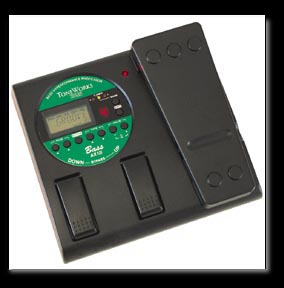|
|
|
 BASS PLAYER's Review:  new Toneworks AX1B Bass Hyperformance Processor. At a mere $170, the AX1B is an impressive little unit. Of course, to keep the price down, careful functionality tradeoffs had to be made. Still, the AX1B is a fun, easy-to-use starter unit that offers surprising flexibility. new Toneworks AX1B Bass Hyperformance Processor. At a mere $170, the AX1B is an impressive little unit. Of course, to keep the price down, careful functionality tradeoffs had to be made. Still, the AX1B is a fun, easy-to-use starter unit that offers surprising flexibility.With a footprint only slightly bigger than larger vintage steel-cased stompboxes, the AX1B fits easily in a gig bag pocket yet has enough room for an expression pedal, a pair of down/up pedals for cycling through programs, and a big, round user interface. This inviting area sports an LCD display window, a single lighted 7-segment program indicator, and seven finger-friendly editing buttons, plus one button each for entering edit mode and switching between program banks. The edit VALUE buttons also act as a master volume; push them at the same time to toggle the unit's metronome. A red light indicates when the expression pedal is active. The pedals and casing are built of sturdy molded plastic, and a 3/64" steel bottom with glued-on rubber feet covers the single circuit board. Four AA batteries power the unit for about 12 hours; an LCD icon warns you when batteries are low. Two thin wires tenuously tether the bottom-mounted battery compartment to the circuit board. An AC adapter jack and cord stress-relief clip are on the back panel; Korg's adapter is an additional $24. Also on the back are the input jack, which lets you switch between low- and high-level signals, and a stereo output jack, which handles headphones, left/mono out, or a TRS cord for stereo effects. Stepping on the two program pedals simultaneously puts you in bypass mode, and
The AX1B's 30 preset programs are arranged in three banks, each denoted by the orange, red, or green bank-indicator light and the red 7-segment program number. The LCD window displays the program's name and symbols indicating which effects are included in the patch. This is great for getting to know your favorite presets and for editing programs, but don't expect to read this LCD on a darkened stage. Take time at home to learn the bank and number of the programs you'll want to use; fortunately, with only 30 presets, this is not difficult. One tester spent only an hour or so experimenting with presets and glancing at the manual, then gigged with the AX1B that night. With more programs, this might have been a more daunting task. Though the AX1B is clearly no high-end unit, it can generate decent-sounding effects. Among the presets we found some very employable tone-shaping patches—"R&B," "MIDFGR," and "SLP DI"—as well as several respectable modulation effects. The choruses, phasers, and envelope-like auto-wah presets are all quite usable, especially "GROOVE," "FUNK," and "LOWFGR." Preset reverbs and delays sound good and are generally not heavy-handed. Distortion presets—like "BRUCE" "BILLY" and "BEAST"—sound a little thin and would benefit from a clean output to preserve the bottom end. In the presets, the expression pedal was too often set up as a volume pedal rather than linked to an effect parameter, but that's easy enough to change. Edit mode reveals the AX1B's true strengths and weaknesses. While you can tweak up to 71 different effects—and use up to seven simultaneously—only one parameter is editable on each effect. For example, most chorus pedals let you adjust chorus speed, depth, and modulation; on the AX1B, CHORS 1 is a speed-constant chorus where depth is the editable parameter, while CHORS 3 is a depth-constant chorus with adjustable speed. Special expression-pedal versions of the choruses and other effects allow you to control certain second parameters in real-time—pretty cool. But using these makes the standard versions unavailable; and some parameters you might want to tweak in real time—like auto-wah sensitivity—aren't available as pedal effect options. Other effects suffer more from the single-editable-parameter limitation. For example, you can't adjust delay times or EQ frequencies; you can only adjust the levels of pre-determined delay times or EQ bands. In this respect the AX1B may not exactly be a full-function effects unit, especially for those accustomed to tweaking studio multi-effects racks, but it still provides enough options to make programming choices reasonably flexible. To keep your edited changes, you have to write over an existing preset patch, since there are no specifically designated user programs. If you want to restore the original preset, you can look up its parameters in the back of the manual, or follow the procedure for reloading all the factory presets. The AX1B remembers your edits even when you're changing batteries. Especially noteworthy are the looping and sampling effects. Though the AX1B is no high-end sampler, you can sample phrases up to 1.8 seconds, play phrases forward and backward using the expression pedal, set loop length with the pedal, and even use the expression pedal to get turntable-like scratching sounds using your sampled riff. Most inexplicable is the amp simulator, which lets you choose between four types of amps. Which amps? Type 1, Type 2, Type 3, and Type 4. The AX1B is not the most flexible, best-sounding bass multi-effects—but if it were, it would cost a lot more than $170. At that price, Korg has done an amazing job of packing the AX1B with impressive features, decent sounds, and a well thought out, easy-to-use interface.
| |||||||||||||||||||||||||||||||||||||||